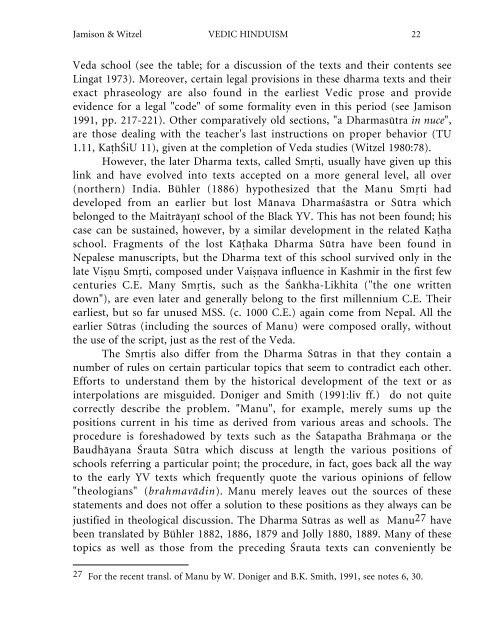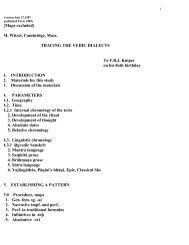VEDIC HINDUISM by S. W. Jamison and M. Witzel - people.fas ...
VEDIC HINDUISM by S. W. Jamison and M. Witzel - people.fas ...
VEDIC HINDUISM by S. W. Jamison and M. Witzel - people.fas ...
Create successful ePaper yourself
Turn your PDF publications into a flip-book with our unique Google optimized e-Paper software.
<strong>Jamison</strong> & <strong>Witzel</strong> <strong>VEDIC</strong> <strong>HINDUISM</strong> 22<br />
Veda school (see the table; for a discussion of the texts <strong>and</strong> their contents see<br />
Lingat 1973). Moreover, certain legal provisions in these dharma texts <strong>and</strong> their<br />
exact phraseology are also found in the earliest Vedic prose <strong>and</strong> provide<br />
evidence for a legal "code" of some formality even in this period (see <strong>Jamison</strong><br />
1991, pp. 217-221). Other comparatively old sections, "a Dharmasūtra in nuce",<br />
are those dealing with the teacher's last instructions on proper behavior (TU<br />
1.11, Ka�hŚiU 11), given at the completion of Veda studies (<strong>Witzel</strong> 1980:78).<br />
However, the later Dharma texts, called Sm�ti, usually have given up this<br />
link <strong>and</strong> have evolved into texts accepted on a more general level, all over<br />
(northern) India. Bühler (1886) hypothesized that the Manu Sm�ti had<br />
developed from an earlier but lost Månava Dharmaśåstra or Sūtra which<br />
belonged to the Maitråya�ī school of the Black YV. This has not been found; his<br />
case can be sustained, however, <strong>by</strong> a similar development in the related Ka�ha<br />
school. Fragments of the lost Kå�haka Dharma Sūtra have been found in<br />
Nepalese manuscripts, but the Dharma text of this school survived only in the<br />
late Vi��u Sm�ti, composed under Vai��ava influence in Kashmir in the first few<br />
centuries C.E. Many Sm�tis, such as the Śa�kha-Likhita ("the one written<br />
down"), are even later <strong>and</strong> generally belong to the first millennium C.E. Their<br />
earliest, but so far unused MSS. (c. 1000 C.E.) again come from Nepal. All the<br />
earlier Sūtras (including the sources of Manu) were composed orally, without<br />
the use of the script, just as the rest of the Veda.<br />
The Sm�tis also differ from the Dharma Sūtras in that they contain a<br />
number of rules on certain particular topics that seem to contradict each other.<br />
Efforts to underst<strong>and</strong> them <strong>by</strong> the historical development of the text or as<br />
interpolations are misguided. Doniger <strong>and</strong> Smith (1991:liv ff.) do not quite<br />
correctly describe the problem. "Manu", for example, merely sums up the<br />
positions current in his time as derived from various areas <strong>and</strong> schools. The<br />
procedure is foreshadowed <strong>by</strong> texts such as the Śatapatha Bråhma�a or the<br />
Baudhåyana Śrauta Sūtra which discuss at length the various positions of<br />
schools referring a particular point; the procedure, in fact, goes back all the way<br />
to the early YV texts which frequently quote the various opinions of fellow<br />
"theologians" (brahmavådin). Manu merely leaves out the sources of these<br />
statements <strong>and</strong> does not offer a solution to these positions as they always can be<br />
justified in theological discussion. The Dharma Sūtras as well as Manu27 have<br />
been translated <strong>by</strong> Bühler 1882, 1886, 1879 <strong>and</strong> Jolly 1880, 1889. Many of these<br />
topics as well as those from the preceding Śrauta texts can conveniently be<br />
27 For the recent transl. of Manu <strong>by</strong> W. Doniger <strong>and</strong> B.K. Smith, 1991, see notes 6, 30.

















